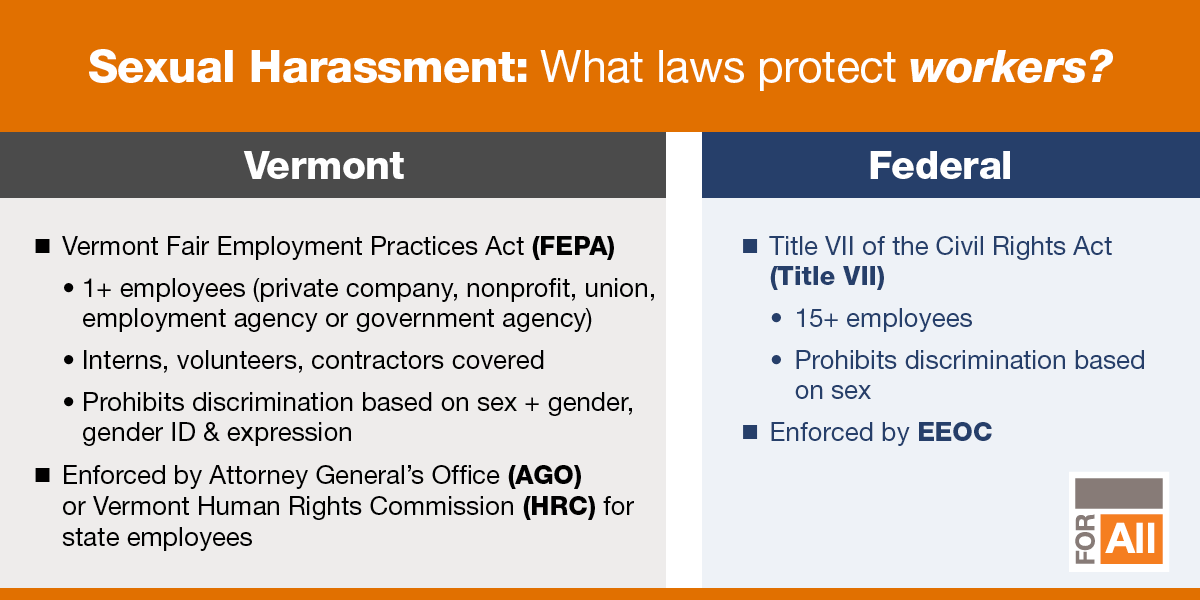Sexual harassment is a form of illegal workplace discrimination. It can have negative impacts on workplace productivity, business profitability, and most especially on the real lives of Vermonters and their families.
Vermont’s Sexual Harassment Prevention Law aims for all Vermonters to have a workplace that is free of sexual harassment. Its provisions for employers go beyond the federal mandates of Title VII of the Civil Rights Act of 1964.
Who must follow Vermont’s Sexual Harassment Prevention Law?
All Vermont employers, subject to Vermont’s Fair Employment Practices Act, who have at least one employee, must follow the Vermont Sexual Harassment Prevention Law. Also, anyone who “engages a person to perform work or services” now has an obligation to “ensure a working relationship with that person that is free from sexual harassment.” This provision, added in 2018, was intended to ensure that people working with independent workers, contractors, interns, volunteers, and other service providers do not sexually harass, or permit sexual harassment against, those individuals.
Who does Vermont’s Sexual Harassment Prevention Law protect?
Just about anyone who works for anyone else. An individual is protected by the Vermont Sexual Harassment Prevention Law even if they are the only worker at a business or organization, or if they are an independent contractor, an intern, temporary employee, volunteer, or service provider.
Any person of any gender can experience unlawful sexual harassment, even someone who is not the target of harassing behavior.
What is workplace sexual harassment?
Sexual harassment is defined in Vermont’s law as “unwelcome sexual advances, requests for sexual favors, and other verbal or physical conduct of a sexual nature constitute sexual harassment when
- submission to such conduct is made either explicitly or implicitly a term or condition of an individual's employment,
- submission to or rejection of such conduct by an individual is used as the basis for employment decisions affecting such individual, or
- such conduct has the purpose or effect of unreasonably interfering with an individual's work performance or creating an intimidating, hostile, or offensive working environment."
See 21 V.S.A. section 495d(13).
Unlawful sexual harassment can take one of two forms - either quid pro quo harassment, or a hostile work environment.
- The Latin term “quid pro quo” literally mean “this for that.” Quid pro quo sexual harassment occurs when an employment decision is based on someone’s willingness to endure sexual conduct, advances, or requests for sexual favors. A single instance of quid pro quo sexual harassment is illegal.
- More often, employees complain of experiencing a hostile work environment based on sex. Work-related harassment that rises to the level of creating a hostile work environment when a person of any gender identity or sexual orientation:
- Has to endure come-ons, unwelcomed sexual remarks, or sex-based behavior as part of their job, or
- Is targeted with harassing behavior because of their sex, or based on conforming or not conforming to sex-based stereotypes, or
- Feels intimidated, offended, scared, unsafe, or demeaned on the basis of their sex or based on sex-based stereotypes.
A hostile work environment is usually a situation that develops over time after frequent or repeated instances of sexual or sex-based conduct occur, and they prevent someone from being able to do their job. However, a single incident, such as workplace sexual assault, can create an unlawful hostile work environment.
Sexual harassment is not about sex - it is about power in the workplace.
Any person of any gender can experience unlawful sexual harassment, even someone who is not the target of harassing behavior. Sexual harassment includes any harassment that is based on sex, or based on someone’s conformance or non-conformance with sex-based stereotypes. Therefore, sexual harassment can occur between members of the same sex and not be related to sexual interest or attraction.
What is not sexual harassment?
The legal requirements for sexual harassment are probably not met when:
- the conduct is not actually unwelcomed
- the conduct is not based on sex or sex-related stereotypes, or
- the employer takes prompt and reasonable steps that actually stop harassing behavior
What are the sexual harassment prevention responsibilities for a Vermont employer?
Vermont’s Sexual Harassment Prevention Law provides specific requirements for all employers.
- Adopt a Sexual Harassment Prevention Policy that informs employees about unlawful workplace sexual harassment, the provisions of the Vermont Sexual Harassment Prevention Law (21 V.S.A. 495h), and how to report sexual harassment.
- Give current and new employees individual copies of your sexual harassment policy.
- If you change or update your policy, make sure all employees get their own copy of the new version.
- Post Sexual Harassment Informational Posters in prominent workplace locations.
- Employers with 5 or more employees must create an internal process for filing and addressing sexual harassment complaints.
- Resolve sexual harassment claims and use waiver agreements in compliance with the 2018 statutory mandates.
Vermont’s sexual harassment law has additional recommendations for employers:
- Conduct an education and training program about sexual harassment prevention for all new employees that begins within the employee’s first year of employment
- Conduct annual education and training programs about sexual harassment prevention for all employees
- Make sure your anti-harassment education and training program for employees includes at least the information contained in the Vermont Sexual Harassment Prevention Law (21 VSA 495h)
- Conduct additional sexual harassment prevention training for new supervisory and managerial employees within their first year of employment.
- Train supervisors and managers about the provisions of the Vermont Sexual Harassment Prevention Law, their specific responsibilities, and actions they must take to ensure immediate and appropriate corrective action in addressing sexual harassment complaints.
- Cooperate with other employers, labor organizations, and appropriate State agencies in making sexual harassment prevention training programs available.
What your sexual harassment policy must say: A checklist for Vermont employers
- Clearly state that sexual harassment is unlawful.
- Define sexual harassment and include examples of prohibited conduct.
- Explain that retaliation for involvement in sexual harassment complaints or investigations is prohibited
- Describe the method(s) of filing a sexual harassment complaint and name the person(s) to whom reports can be made. (It is recommended that, whenever possible, the policy should identify more than one person in case there is a conflict.)
- State that investigations may be conducted regarding harassment complaints
- Warn all employees that anyone found to have committed harassment will face consequences, and describe what those consequences could be (such as disciplinary or corrective action).
- Inform employees about how to make complaints to the Vermont Attorney General's office, or the Equal Employment Opportunity Commission, and/or the Vermont Human Rights Commission for State of Vermont employees.
Below are additional requirements and recommendations under Vermont law about how employers must inform employees about the sexual harassment policy and changes made.
Implementing your sexual harassment policy: Essentials
- Ensure that all current employees have a written copy of the current employee policy regarding sexual harassment
- Give all new employees a written copy of your sexual harassment policy at the start of employment
- Ensure that all employees are notified in writing of changes to your employee policy regarding sexual harassment
- Train anyone who is named in your policy to receive harassment complaints about how to carry out their important duty to address unlawful conduct in the workplace
- Optional but encouraged: whenever possible conduct trainings for all staff about your sexual harassment policy and how to detect, report, and prevent sexual harassment
See also the Model Sexual Harassment Policy developed by the Vermont Department of Labor.
In addition to the sexual harassment policy required under Vermont law, employers can also use a workplace harassment policy that applies to all forms of harassment based on membership in any protected category, as part of a comprehensive harassment prevention program.
See the EEOC’s Harassment Policy Tips for Small Businesses.
Settlement of sexual harassment claims
In 2018, legislative amendments to Vermont’s Sexual Harassment Prevention Law changed the terms under which employers can settle sexual harassment claims made by current or former employees. Employers should be aware of the following new statutory requirements for all sexual harassment settlement agreements:
- Settlement terms cannot prevent the employee from ever applying to or working for the company, parent company, subsidiary, or affiliates again.
- Settlements cannot waive future rights or claims, which arise after the date of the agreement.
- Settlement terms may not “prohibit, prevent, or otherwise restrict the individual who made the claim from doing any of the following:
- lodging a complaint of sexual harassment committed by any person with the Attorney General, a State's Attorney, the Human Rights Commission, the Equal Employment Opportunity Commission, or any other State or federal agency;
- testifying, assisting, or participating in any manner with an investigation related to a claim of sexual harassment conducted by the Attorney General, a State's Attorney, the Human Rights Commission, the Equal Employment Opportunity Commission, or any other State or federal agency;
- complying with a valid request for discovery in relation to civil litigation or testifying in a hearing or trial related to a claim of sexual harassment that is conducted by a court, pursuant to an arbitration agreement, or before another appropriate tribunal; or
- exercising any right the individual may have pursuant to State or federal labor relations laws to engage in concerted activities with other employees for the purposes of collective bargaining or mutual aid and protection…”
Settlement agreements that do not comply with the above requirements may be considered null and void. See 21 V.S.A. section 495h.
See How to Prevent Harassment: Best Practices for more information and recommendations about what you can do as an employer to prevent sexual harassment and other forms of harassment from occurring in your workplace.


